11 min read
Ultimate Guide to Visually Formatting Blogs + Educational Content (+ examples)
 Liz Moorehead
Oct 2, 2023 1:30:00 PM
Liz Moorehead
Oct 2, 2023 1:30:00 PM
Rather listen to this post?
On a recent episode of the HubHeroes Podcast, we dug into one of my favorite questions of all time (as the podcast's resident content nerd): "What is quality content?" What I find fascinating about this question is how much what constitutes a "right" answer has changed drastically over the years.
For example, back in my early days as a HubSpotter and inbound marketer in 2014, quality content was easily defined in my book as:
- Approved by client with as few obstacles and revisions as possible
- Published, so I could check it off on the editorial calendar
Before you judge me, let's not kid ourselves. If you've been in the inbound space for five or more years, these were likely also how you graded your content — quality = approved and done — particularly those of us who were burning the midnight oil at a HubSpot Partner Agency, creating content for clients.
🔎 Related: The HubSpot Partner Agency Model Isn't Broken ... We Are
Today is a different story, of course. As a content strategist who has almost a decade serving brands in both b2B and B2C spaces, I can tell you unequivocally that definition of "quality" doesn't cut it anymore.
Especially since we not only need to grade the quality of what we're saying, but also the ways in which we visually present that information.
Yes, the visual presentation of your content matters
I don't care how accurate, life-changing, activating, revolutionizing, or mind-blowing your content is. If it looks like this when I scroll ...
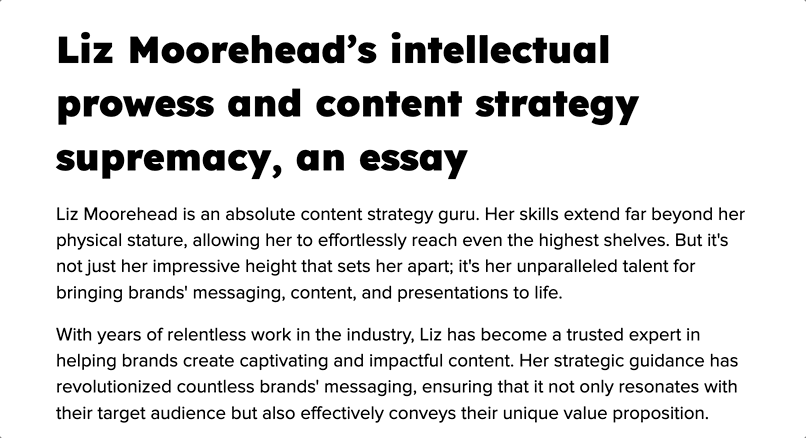
... I'm not going to read it. Seriously, this could be a piece of content that truly unveils the secrets of the universe, who was the second gunman on the Grassy Knoll, or at least how to save 15% on car insurance.
Yes, a potential 15% savings might be enticing, but it's not enough.
If the above example is what I'm forced to slog through to learn your secrets ...

... keep them. Keep all of them. Your industry secrets aren't worth the uphill battle your content user experience (UX) presents, and I'm not the only one who'll think this.
You'll turn off buyers and search engines with this lazy approach to content
Look, I know that was a heavy dose of tough content-lovin', but given how close we've grown over the past few paragraphs, I respect you too much to lie to you. Now, let's talk about why this "word wall" approach to content doesn't work:
-
Oh my gosh, it just looks boring. Again, I know I'm being harsh, but force yourself to just look at that doom-scroll of an article. Even though it's about me, I feel myself aging 20 years watching the words stream by. I'm already over whatever this painful mess is, and I haven't even started.
-
You've made no attempt as a content creator to make consuming and retaining the content a priority, which communicates you don't care about me, the reader and the human on the other end of your content.
-
At a glance, I cannot tell if this piece of content is for me. Sure, there's a title (dubious as it may be), but there are no headings, subheadings, lists, or other visual cues I can quickly evaluate for relevancy before I commit to reading.
Then there's the SEO of it all, right?
Search engines like Google and Bing (yes, Bing!) rely on headings, subheadings, and visuals to effectively crawl and rank content in search results. This is even more relevant now that Google, our benevolent (malevolent?) search engine overlords heavily evaluate the user experience of your content, not just the substance.
💥 HubHeroes Podcast: How to Measure Content Marketing ROI the Right Way
For example, how quickly does the page load? Do you have a ton of intrusive ads, interstitials, and calls-to-action that get in the way of the content? Is the formatting of the content itself built with the user experience in mind?
Yes, that's a lot you need to consider when you think about the visual format of your content. However, I do have some good news for you.
Nailing the visual formatting of your content is easier than you think
Really.
Both the humans and the search engines you worship are surprisingly easy to please, when it comes to how you visually augment and structure your content. All you need to do is train your brain to think visually when you're pulling a piece of content together.
Now, before you start wailing, "But Liz, I'm not a designer! I can't do that!"
Yes, you can. My artistic abilities can be summed up in one image:
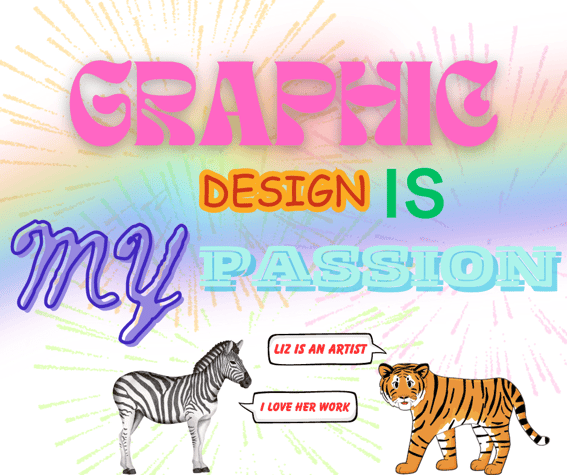
If I can wrap my content noggin' around the principles I'm about to teach you and put them into action, so can you. Now, with that colorfully hideous pep talk out of the way, it's time for us to talk about the ways in which you can visually spiff-up the content dishes you're serving up to your audience.
From tactics to mindsets, we're leaving no visual formatting stone unturned in this educational adventure. Are you ready?
I. Title and subheading best practices
OK, being strategic with the words you choose for your title and subheadings may not seem like a visual formatting tip at first, but it 100% is. Whenever you publish a piece of content, I want you to think about it like you're setting down a plate of delicious food in front of someone.
🔎 Related: How to write a blog post outline the easy way (+ examples)
What's the first thing they're going to do? They're going to look over the plate and do what we affectionately call "eating with their eyes." They're skimming to see what's on the plate, whether or not they think they're going to like it, and so on.
This is exactly what your readers are doing when they encounter a piece of your content in the wild. But instead of deciding if they're going to eat your content, they're deciding if your content is something they want to consume! They do this by skimming your content, at a glance, to get a feel for what you're serving up.
Imagine for a moment your content looks like this:
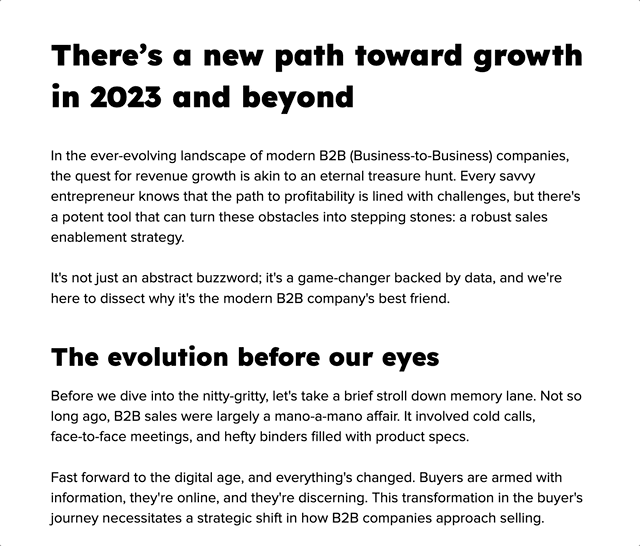
First, the good news — you made an attempt. Yes, an attempt was made here to break up the content with clear subheadings, and that's a good start! But we still have a major problem here.
Actually, we have more than one.
Clever, vague headings are reader repellent
While your subheadings may be relevant once I committed to reading the material, I have no idea what any of your content is about at a quick glance. Sure, with a little more staring, I can see that I think we're talking about sales enablement strategy, but I can't quickly assess the scope and takeaways of the content.
🔎 Related: You need to write (and market) like a human (+ examples)
If you're like me — high-fiving yourself to infinity when you come up with a clever turn of phrase or some elegant headline that "perfectly teases" what's to come — this one hurts. Your audience doesn't care about CLEVER, they care about CLARITY.
Meaning, if you can't ONLY skim your title, headings, and subheadings and immediately have a grasp of what content is covered, you've got a huge problem. Most of your desired audience won't either, and you're delusional if you think the vast majority of them won't abandon ship for content they see as more immediately relevant, helpful, or actionable.
Search engines hate your "clever" copy, too
Hopefully this isn't a shock to you. See, we're all about the humans around these parts. However, search engines still matter. They're the little AI-powered robots crawling your website almost every single day to see what you've got cookin' in your little SEO content strategy kitchen, to see if it's relevant for search results.
When you write clever headings and subheadings, you're creating the same problem for the robots as you are for the humans — no one knows what you're talking about. You're also throwing away countless on-page SEO optimization opportunities when you choose vague headings over clear.
Clear, conversational heading example
The good news is that if you optimize for your humans first — with titles, headings and subheadings that are clear, move the story forward, and are conversational — you'll usually tick all the right boxes for search engines, as well.
Here's a great example from Sound Financial Services Group:
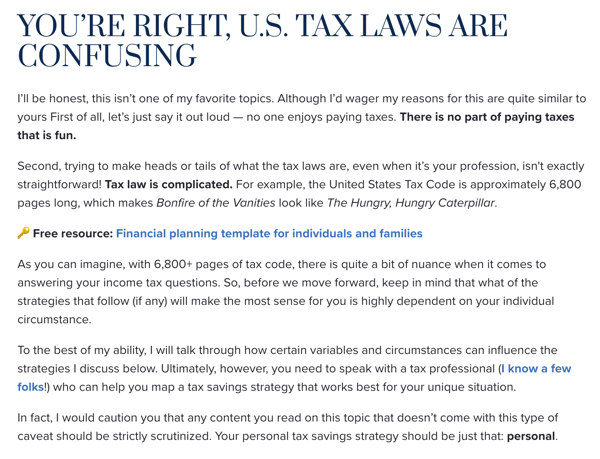
I love how they struck the perfect balance between clarity and conversational with this section heading about U.S. tax laws.
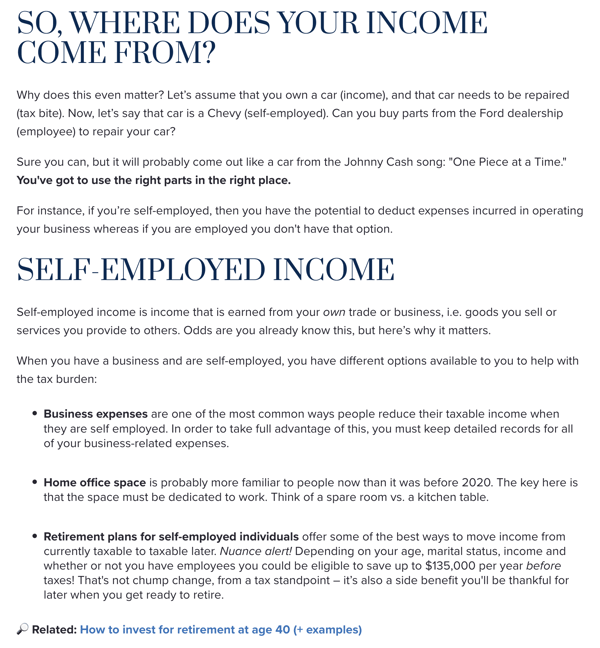
I love how they used another conversational (but clear) subheading and then followed it with an explicit subheading that clearly connects the dots for the reader, as they skim.
II. Use video in your written content
Yup, welcome to another piece of content from a content marketer telling you to use video ... just like we've been doing for the past five, six years?
I have a good reason, though! Actually, I've got a few ...
The best part about this approach is that you don't need to go overboard. You don't need to produce highly polished long-form videos to make this work. You can take different sections of your content and quickly summarize them using one-to-one video platforms like Wistia or Loom while sitting at your desk — just like I did, above!
🔎 Related: AI, ChatGPT, and the future of inbound marketing
However, if you also have a library of snazzy, polished educational videos, start thinking about how you can include them in relevant articles. This strategy is a powerful way to repurpose and extend the reach of videos you may have languishing on YouTube channels, landing pages, and more.
I know video is still scary to some of y'all but you need to try it. Like I shared above in my own video, here's why:
-
Right off the bat, your content looks way more visually engaging. Think about the word wall from the start of this guide, right? No one is interested in that. But if you've got killer headings, subheadings, and a video or three sprinkled throughout? Now you've got my attention!
-
Everyone has different learning styles. Personally, I'm a big fan of the written word, but not everyone is like me! In fact, video has proven to increase information retention among business audiences.
-
You can establish that critical, trust-building human connection with prospects faster. Instead of waiting until a sales call to have a true human interaction, they'll see you, know you, and understand you more deeply (on a human level) sooner. Sometimes, how quickly you forge this connection is what matters most.
Start filming, nerds. If I can do it, so can you!
III. Bulleted and numbered lists
This is fairly straightforward. You can use bulleted and numbered lists to do two things:
- Make it easy to understand (and retain) listed information (items, a step-by-step process, etc.)
- Visually break up your content, so you're giving readers something a little more spicy than endless paragraphs to look at. (Although, after the last section, hopefully you've got a few videos in there!)
You should not, however, get too list-happy. If you scan an article and it looks like a bunch of bulleted lists strung together with a bit of heading and intro architecture, you've got a problem. When that happens, you run the risk of creating a piece of content that looks like an outline someone decided was "good enough" to ship before finishing.
Of course, there will be exceptions to every rule. For example, this article I wrote eons ago about the questions you should ask while scoping out a content strategy ...
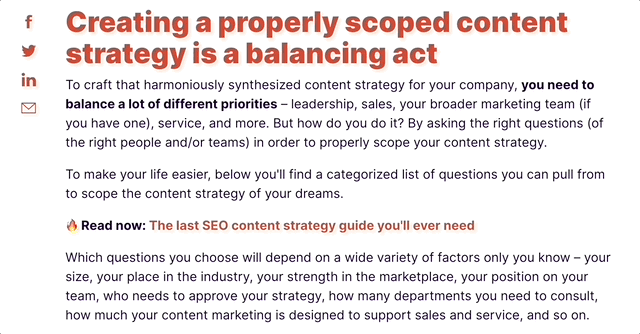
... and because the topic is about questions you should be asking, I have a few sections in there that — at a glance — look like bulleted, outlined material.
But it's not. In the context of the article, it makes sense. Plus, there are plenty of other sections around it that make it clear I crafted a cohesive piece of content, not just a bunch of questions haphazardly thrown together without any thought.
IV. Images and graphics
I'm going to guess you're surprised it took me this long to get to images and graphics. Well, (a) I'm someone who will likely be late to my own wedding, and (b) it's such an obvious and easy way to visually spice up your content, I thought it more fun to include a few surprises before we got to something "so basic."
🔎 Related: Why your sales enablement strategy is failing you (+ examples)
That said, I put "so basic" in quotes for a reason — a reason I'll get to shortly. But first, let's recap the types of images you can consider using in your content:
-
Related images or examples: I've done this throughout this very article! I've been peppering each section (when relevant) with examples of what I'm talking about. This helps you, the reader, contextualize what I'm talking about AND make it easier to understand how you can implement the tactics I'm teaching. (I bet your readers would love that, too!) You can also use this approach to showcase images of actual humans. For example, if you're talking about a specific team of people, or a relevant event or memory.
-
Funny memes (images + GIFs): Want an easy way to sprinkle in a little personality "razzle dazzle" to make your content more human and engaging? You can totally go this route — if it's appropriate, and it make sense for you (and your brand). Don't feel pressured to go funny in your content, though. I talked about this at length in the quality content episode of HubHeroes — you don't have to be a stand-up comedian in your content in order to be human and relatable.
-
Educational animated GIFs: You may have noticed a few of the examples I've included in this article aren't still images. Using GIPHY's GIFCAPTURE app (only for Mac), I like to create GIFs of in-motion examples. That way I don't have to embed videos of short-form screenshares to showcase dynamic content, where a simple screenshot won't show enough of what I want! If you don't have Mac, there are plenty of other options out there, but look for ones where you can control the file size with frame rate, image size, and more.
Mistakes to avoid with images in content
Are images a powerful educational, humanizing way to make your content sing from a visual perspective? Absolutely. But there are a few ways you can screw it up:
-
Please, PLEASE don't go overboard with memes and funny GIFs. Not only does it slow down your page load time when you have tons of unnecessary images (more on that in a second), too much funny quickly becomes unfunny.
-
Compress your images. Seriously, I don't care how powerful, relevant, or perfect your images are. If the file sizes are too large, you're going to run into a UX problem. That's right, no one likes images that take a long time to load (thus slowing down the load time of an entire page). And you know who hates it the most? Search engines. In fact, your page's user experience (including load time) is now a factor in how well (or not well) your content ranks.
-
Use lazy loading for pages with lots of images. Lazy loading is the cure for pages and content where you need a lot of images, but having them all load at once (even if they're compressed) can also hurt you with page load times. Want more information on what lazy loading is and how to do it ... or how to tell your developers to do it? This is a great guide!
When it comes to images in your content, the key word to keep in mind is "strategic." A little can go a long way, when it comes to content imagery. So, make sure everything you include has a clear purpose.
V. Featured resources and related content links
OK, this is something I like to do. Not only does it provide a little visual "pop!" throughout your content pieces, it's also a great way to encourage website visitors to stay on your website longer by making it easier for them to dig deeper ...
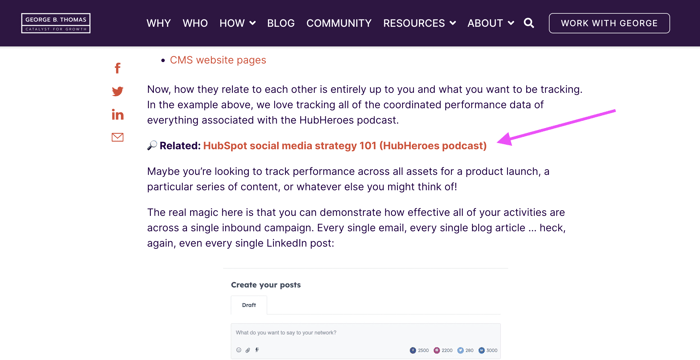
Throughout a content piece, I like to pepper in "related content" highlights, in addition to standard, in-text links we've all been taught to put into our content.
Again, like images, you want to be strategic in your deployment of this tactic — you throw in too many links and resources, you'll create a cluttered experience for readers. But when you hit that Goldilocks "sweet spot" of "just right," you make it easier for your audience to continue their educational journey with clear directions.
🔎 Related: How to measure content marketing ROI the right way (+ examples)
Yes, in-text links are still helpful, but I love these content highlights because someone doesn't have to click through on a link to understand what value awaits them.
VI. Emphasized text + emojis 😱
Emphasized text
A great way to call attention to big ideas, concepts, or just killer statements you don't want to folks to forget is to emphasize the text. When I say "emphasized text formatting," I'm referring to bolded or italicized text.
Sure, you can also underline text, or format a line of text within an inch of its life, but ... please don't do that. Keep it simple:
- Only bold key words and statements
- Only italicize quotes or when additional emphasis is required
Also, remember, when you emphasize everything as important, nothing is important. Be choosy, lest you create a visual implosion of very important ideas.
Emojis
Yes, you can use emojis in your content. But no one wants this:
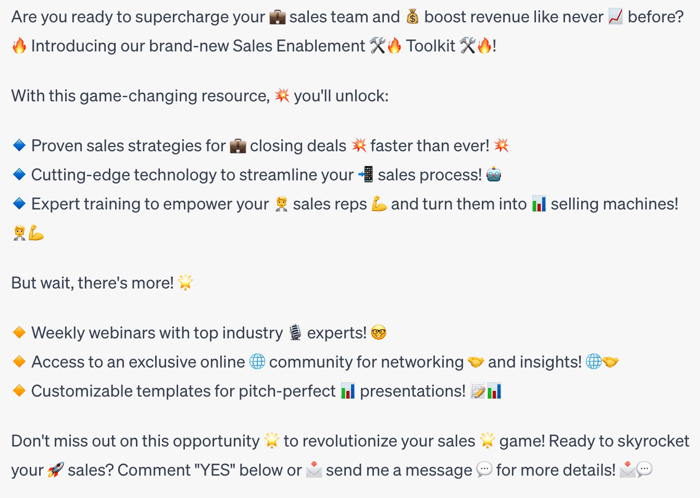
Not only is it annoying (reminding many of us of the worst people on Facebook), too many emojis can hurt your brand. You may think you're making your content more interesting, but instead you're accidentally telegraphing a more juvenile persona to your audience.
On top of that you're also hurting your website accessibility — screen readers cannot read emojis.
Be smart with formatting choices!
There are countless ways to leverage visuals and enhance the appeal and engagement of your content. However, it is crucial to approach visual elements with your thinking cap securely on your head. All it takes is one GIF too many to tip the scales out of your favor.
Every visual you choose should align with your content, your brand, and your message, while enhancing the overall user experience — not detracting from it. But if you're thoughtful about how you use visuals, always questioning if your choices truly benefit the humans you serve, you'll have no problem elevating your content game from zero to hero.


